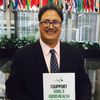The developing world is changing exponentially. Economically, demographically and epidemiologically, we are witnessing dramatic shifts in wealth, education and health. Many countries in Africa and around the world are seeing an unprecedented growth in their GDP, and this economic transition has meant that most countries categorized as low-income in the year 2000 will become middle income by 2020. These are remarkable achievements, an acceleration of a rather successful story in international development.
The shift in health has been accompanied by equally significant improvements in life expectancy in the world. The incidence of new HIV infections has been reduced by 50 percent in the last 15 years and since 1990, nearly 100 million children's lives have been spared. Family planning has contributed to reducing the rate of maternal mortality by half, empowering women and propelling a demographic dividend that has played an important role in the economic emergence of Latin America and Asia in last decade. Countries should increasingly focus on issues of equity and quality, as next the generation expands its focus from survival to well-being.
For those of us in the business of international development, these transitions -- alongside better governance and greater trade and investment -- represent great success. It means with the exception of a handful of frail states, we are no longer working with our country partners within the framework of "this is what the U.S. can do for you," but rather, "how can the U.S. work with you to reach your goals?" It also means that as developing countries grow in the next decade, they will inevitably spend more on health and on building the institutions that can strengthen their existing systems. International assistance would rightfully shift to capacity building, technical assistance and greater coordination. This will eventually lead to improved sustainability and efficiency, an important milestone not just for the U.S. government but also for the U.S. citizens who have made it possible.
This year, as we come together to commemorate World AIDS Day, we at the U.S. Agency for International Development are reminded of how far we've come in the fight against AIDS and in our work under the U.S. President's Emergency Plan for AIDS Relief. We have witnessed an enormous shift in the epidemic and in our response. Twenty years ago -- even 10 years ago when the United States Leadership Against HIV/AIDS, Tuberculosis and Malaria Act of 2003 was passed into law -- all we saw was an epidemic raging out of control. Our goal was to reach as many people as quickly as possible with life-saving treatment in order to save an entire continent of people. Now, with investments made through PEPFAR and the Global Fund Against AIDS, Tuberculosis and Malaria, we are contemplating the beginning of the end of AIDS. This is true particularly in Asia where new infections are now lower than mortality, but gains are also apparent in many African countries hardest hit by the epidemic. Much remains to be done, however, to contain more targeted epidemics impacting populations disproportionately impacted by HIV, such as men who have sex with men, sex workers and people who inject drugs.
With the economic transition of health occurring over the next 15 years, most partner countries will increasingly dedicate domestic resources to fight HIV and AIDS and other infectious diseases. Country ownership and a commitment to a shared responsibility will become an even more critical component of an AIDS-free generation, as we are already witnessing in Asia and Southern Africa. Our role as a donor is evolving as well. As both Secretaries of State Hillary Clinton and John Kerry have stated, a model of shared responsibility will be the cornerstone to sustaining development and shifting our approach and thinking from aid to investment, innovation and partnerships.
We have a lot to celebrate today. And, while our work in HIV and AIDS is not over, we have a tremendous opportunity to demonstrate shared responsibility by making smart transitions, identifying strong, strategic partnerships and leveraging new opportunities that will help countries further their goals and their own responses to their epidemics. Above all, we must recommit to redoubling our overall effort to ensure an AIDS-free generation in our lifetime.
